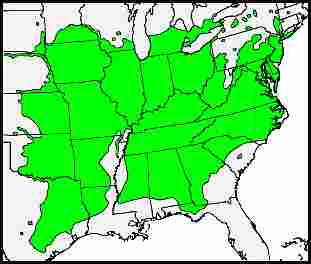Black Walnut
(Juglans nigra)
Black Walnut is native to a large part of the eastern United States, but because so many trees have been cut down for their valuable wood, the species has become rare in many areas. The high-quality wood has long been prized, especially for fine furniture and cabinet making. Rarity increases value, and the tree wasn't common even before large-scale harvesting began.
To increase the supply, the tree is now grown on farms and plantations, often using special fast-growing strains. Such trees generally don't contribute to the numbers or the gene pool of the wild population. But commercial growing does help the wild trees indirectly, since fewer of them are harvested. In fact the species may have started to comeback in some areas.
Some growers also collect and sell the nuts. A tree begins producing a small crop at about the age of ten, and most mature specimens are consistent bearers. The nuts have a very hard shell, but somehow squirrels are able to open them and get to the tasty meat. New trees sometimes grow from nuts that squirrels bury and never retrieve.
The species is also called American Walnut. In the forest it generally grows as an isolated specimen or in small groups. It is fairly long-lived, and can become quite large, up to 150 feet tall. The compound pinnate leaves don't appear until late spring and usually drop early in the fall.
Black Walnut is a tough, vigorous, easy-to-grow tree. It is sometimes planted in lawns, but is probably better suited to the back of the yard or a semi-wild area, where the falling nuts won't cause problems. The tree can also be difficult to garden under because it produces a chemical called juglone that is toxic to some plants.
Other Information
Scientific Name: Juglans nigra
Common Names: Black Walnut, American Walnut
Plant Type: Large deciduous tree
Height: 70 - 150 feet
Cultivation Zones: 5 - 9
Native Habitat: Mixed forests, especially in lowlands and near streams
Native Range: Much of the eastern United States. See distribution map below.
Distribution Map

Range Map Source: U.S. Forest Service. (See General Note C)
Cultivation: Black Walnut can survive on poor sites, but will grow best in rich moist well-drained soil in a sunny location. It has a long taproot which makes large specimens difficult to transplant, but gives established trees tolerance to drought. Go to Cultivation for more information.
Plant Sources: Possible sources of this species include Woodlanders, Musser Forests, Oikos Tree Crops, and Forest Farm. Some fruit and nut nurseries sell special strains selected for fast growth and/or good nut production. These won't have the genetic variability of a planting of typical wild trees. Note that plants from a southern seed source may not do well in the north. For links to the mentioned suppliers, go to Sources of Plants.
|

